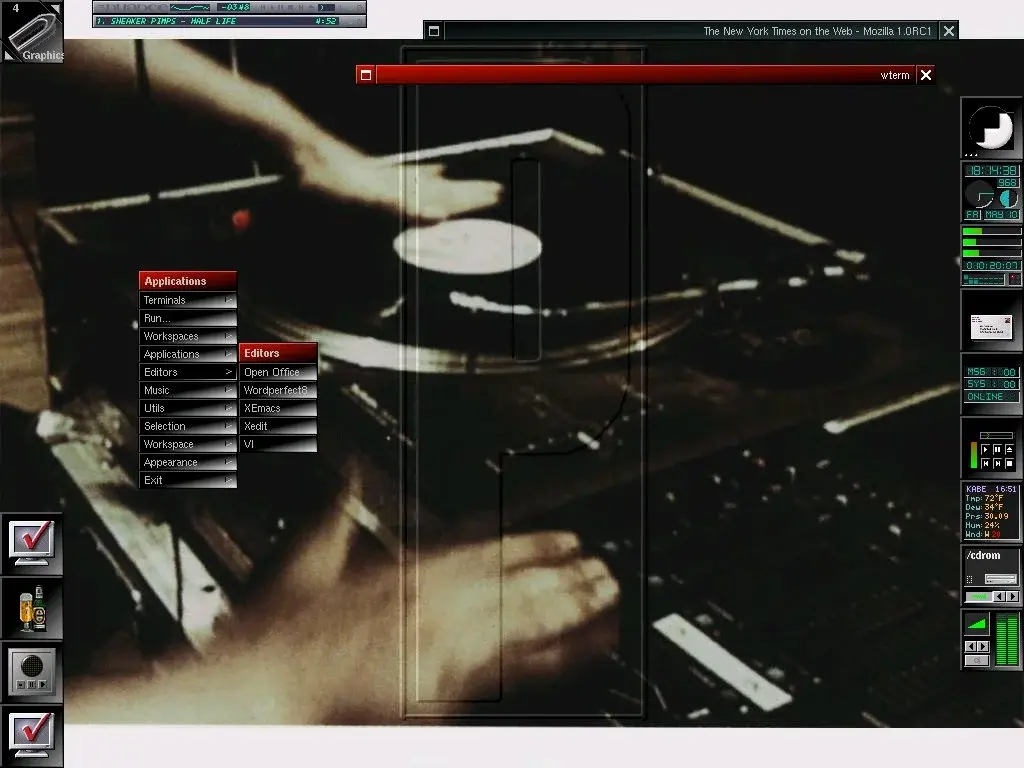After years of using Gnome 3/4 with a modified setup on Debian, I returned to Xfce, and am quite impressed by the state of Xfce 4.18.
My background: Using Linux since 1998 or so (yes, I am old) as my main OS, I used a lot of different window mangers and DEs.
Gnome 3 actually never really matched my personal workflows, but I always discovered many paper cuts using other desktop environments and thanks to dconf at least I could automatically configure Gnome 3 in a way which made it usable for me.
For life reasons I needed a cheap, small sub notebook (or netbook, as it was called when I was younger), and settled on the HP Stream 11 with an N4120. No way to run Gnome on this machine and work fluently, so I recalled that Xfce was at the sweet spot between being full featured, fast and light on memory. (+stable and Gtk+ based, KDE hasn’t been an option for me since 3.5 and I check it regularly.)
I got more than I bargained for, Xfce felt so quick, responsive, good and simply sane that I run it now on every Linux desktop/laptop I own. (But my entertainment system, which I only use for Netflix.)
What I really like about Xfce 4.18:
- Speed and responsiveness, even on my beefy machine I feel the difference
- Sane size of titlebars etc.
- Customizable panels out of the box and xfce4-panel-profiles for 1 click setups
- Thunars split view. I get tired by the Gnome developers, who removed this feature from Nautilus, explain that two Nautilus windows side by side are equivalent to a split view. It is not
- Ansible support for xfconf out of the box to automate the deployment of my configuration
- Light on RAM: Around 400 MB vs a little above 1 G for Gnome
- Everything I need for my DE is included, no search for plugins which might or might not fix my problems
- Useful and fast default applications (Thunar, Mousepad, Parole…)
- After tweaking the hotkeys/shortcuts a little bit a perfect keyboard driven experience
So far the only ‘downsides’ I have with Xfce 4.18 is the lack of Wayland support (AFAIK coming with 4.20), the Terminal does not resize the text area if you add new tabs (easily fixed by configuring it to always show the tab bar in the terminalrc) and the type-ahead launchers (whisker-menu, xfce4-appfinder) are ‘weaker’ than the type-ahead launchers in Gnome/KDE.
Big shout out to the Xfce developers for this excellent desktop environment!
tl;dr: If you haven’t used Xfce for some time, give Xfce 4.18 or later a try, you might like it.
Kudos to the XFCE developers for creating and maintaining a sleek, fast, sane desktop all these years.
It has served me well after the Gnome 3 debacle pushed me overboard.
xfce is the best … no useless gimmicks, just functionality and speed. beautiful
Nice summary. This is how I like all of my software!
How can a website exist today that looks like ass on a phone?
Oh my god, yes. Go look at distro watch. It’s a horror show.
They are working on it. Some web dev already sprawling to xfce forums… So… Yeah
Quality engineering! :-P
Xfce has been my go-to for over a decade. It is one of those pieces of software that is so stable and reliable that I genuinely forget it exists most of the time, I take it for granted. That is a property of a quality piece of software.
For the launcher you should try rofi, there is nothing running as a daemon. It runs fresh everytime but it is still quick and looks nice if you want to make it look nice.
Thank you for the advice, I’ll give it a try!
Yes XFCE has come a long way and if themed properly can look quite nice. It’s refreshing to see a desktop that isn’t involved in politics and just quietly gets on with it.
Having said that I prefer Cinnamon because it’s like XFCE but just more modern. Same goes for Mate. It’s similar to XFCE but also different.
These are probably the best 3 desktops on Linux atm with KDE and Gnome being the “big boys”.
I liked KDE but now that my eyesight is worse I can’t use it - it’s illegible. Gnome is better with that but heavy on RAM. Plus the Gnome people make some strange choices. And I’m but overly fond of having to install extensions to make the desktop usable…
So what is the result of not having Wayland support? I’m using Gnome at work and awesome at home. AFAIK Gnome support Wayland and awesome does not. I don’t see any difference in how apps work. What are the features that Waylands has and X11 doesn’t?
In my case, better support for VMWare Fusion… I am forced to run macOS as host at work. In the current version of VMWare Fusion, Wayland desktops resize dynamically with the VMWare Fusion application window, Xfce on Xorg does not.
Otherwise I agree that for everyday usage on real hardware I could not observe a difference between Xorg and Wayland.
Wayland is more secure, better at handling mixed refresh rate monitors, and much more modern. Another thing that I like is that apps don’t have as much control over the positioning and focus of their apps, so apps open in more consistent locations and are less likely to steal focus.
I’ve seen the thing about ‘mixed refresh rate monitors’ couple of times and I also don’t get it. What issues are people having? Is this a gaming thing? Maybe I’m old but I just set the resolution to one that let’s me see things on the screen and I’m done. Some laptops have max resolution so high I can’t see the tiny font so I just set a lower one. That’s it. What are people doing on their screens that refresh rates and fractional scales are an issue for them? Is it really useful and I’m missing out?
As for focus and positioning both Gnome and Awesome have settings for this and I never had issues with any of it.
I’ve seen the thing about ‘mixed refresh rate monitors’ couple of times and I also don’t get it. What issues are people having?
If you use multiple monitors, X treats them as one big monitor. And it will refresh that one big monitor at only one refresh rate, usually the slower one.
Say you have a 144hz monitor and a 60hz monitor. X will choose to refresh that one big monitor at only 60hz. So if you drag windows around on your 144hz, it will visually look like 60hz.
There are some exceptions to this. The cursor will move at the highest refresh rate if it’s operating in hardware cursor mode. In software cursor mode, it will look laggy. Games will usually operate at the higher refresh rate.
fractional scales are an issue for them?
This is a whole other issue. Not everything implements fractional scaling nicely. For example, currently GTK handles fractional scaling by rendering at 200% scaling, then resizing the output. This uses more more processing power and uses more battery. And things are fuzzy. As for why, imagine you have a 15 pixel wide element at 100%. With fractional scaling at 125%, that element is then supposed to be 18.75 pixels wide, which is impossible. So what do you do? Round up? Round down? Same question for a 17 pixel wide element, at 125%, it would be 21.25 pixels wide. Round down? Round up?
Some toolkits don’t do the render at 200% then resizes method, but still suffer from other issues.
As for focus and positioning both Gnome and Awesome have settings for this and I never had issues with any of it.
Most stuff follows the rules, but not everything. Discord, Steam, and Bitwarden ignore my settings under X. But I can force Discord and Bitwarden to run using Wayland, which fixes the issue.
I guess I AM old but I never really cared about the refresh rate of my cursor while coding in nvim or browsing web pages. I don’t even know what refresh rate I current have… As for fractional scaling I just change resolution to lower one and everything is bigger. Never needed 125% scaling. But I get it, some people have different needs. I’m happy to keep using X11 forever.
I think that what keeps most folks away is the default look of xfce, because I can’t see an other reason it is not more popular
I mean, I imagine a primary reason is also that the mainline distros don’t use it by default, necessitating one to look for “spins/flavors/whatever” that use it instead.
IMHO Xubuntu and some other distributions do a fine job of providing a decent look for Xfce, still I very much agree: The OOTB configuration of Xfce leaves much to be desired.
Yes, I was talking about the OOTB experience, because I used endeavouros with the default xfce look for a long time, and I enjoyed it a lot
Xfce reminds me how bad are modern softwares.
Xfce keeps an old design and the result is more flexible and fast than modern DEs. Whats wrong with nowadays developers ?
Xfce is a great example of how solving a problem in the best way results in low adoption.
People tend toward extremes. There is something in particular they really want, and they will gravitate toward the product that gives them the most of that thing.
I want total control over configuration: KDE Plasma
I want maximum performance: LXDE
I want something that looks good and I don’t want to think about it: GNOME/CinnamonXfce isn’t on this list! It’s not the best at anything. But it’s pretty good at everything. It’s an overall best (in my opinion) but because it’s not beautiful, nor lightning fast, nor incredibly flexible, nobody will ever take it as their first choice. And the majority of people make a first choice and then never change, as whatever they start with is probably good enough for them. I’ve tried all of the DE’s listed above, but I’m the crazy guy: that’s a lot of work and churn! Any and all of them work well enough, why bother installing 5 separate environments?
If you want to develop something and have people adopt it, then your goal is to have a killer sexy feature at the expense of all else, rather than to be satisfactory in every metric.
I would Xfce give the first position on usability and ‘bang for the buck’. ;-)
Still, it for sure doesn’t help that the big distributions default to Gnome mostly.
Back then ™ developers where a self selected bunch of people with a lot of knowledge about how computers work on a fundamental level. We had less distractions and much more limited computers and no internet, which meant we had to figure stuff out by ourselves and we had more time™ because of less distraction.
Fast forward to today: IT salaries are good, so lots of people are in it for the money (no blame here, people have to make a living), the development machines are quite beefy (at least in the western hemisphere), more distraction (internet) and most technologies are very high level so the developers don’t learn ‘mechanical sympathy’ anymore.
I never stopped using Xfce. I try Gnome and KDe every other year or so to see if I like the feel of it and just am not into it. I do keep my set up really basic though. The only issue I have is I cannot right click in Thunar to bring up context menu without it hanging/freezing my entire system for a minute or so. Now I just use a different file manager.
Your right-click issue sounds very strange.
I am running Xfce on a real potato and right click is instantaneous.
Do you use any dynamic/on the fly menu creation?
None that I know of. I don’t do much customizing or tinkering which is why I was confused when the issue started a few years ago. I did try to troubleshoot for a while by resetting or deleting various config files I could find and nothing helped so I just found an alternative file manager that does what I need.
XFCE has two different launchers:
alt + F2for executing anything on your$PATHandalt + F3for starting installed programs (I think these need an*.desktopentry). The latter is neat, because it learns what you open the most. Also, you can entirely hide the category tab by resizing it. This way you can use your arrow keys to change the selection more easily.*fliesaway*
Thank you very much for the hint. F2 and F3 start both xfce4-appfinder, will have to figure out if the non-collapsed (=F3) version behaves different for me.
Thanks a lot @mryessir@lemmy.sdf.org!
I don’t understand why the xfce4-appfinder behaves so differently when started with the --collapsed option, but basically the F3 version works exactly how I need it/expect it and the F2 version does not.
Very nice to hear!
The F2 version enables one to directly call scripts by e.g. issuing
sh myscriptfrompath.sh. Or start a program within a terminal:st -e top. The F3 version wouldn’t accept these.My usage is 95% of the time F3 - and I am a sw engineer. So very specific reasons.
I am really glad you liked it and prompted your question. I was playing for hours until I simply dragged away the categories 😅😃!! Now it is preserved :)
Yeah thanks again very much for your advice!
I started using XFCE because of GNOME 3, it wasn’t for me, and XFCE where more customizable, it suited my need. On GNOME each new version breaks extensions, or stick with the old one, just a headache.
This!
Every time there was a new stable release of my distribution, with Gnome I was feeling stressed:
What functionality would they remove this time? Will at least my most important plugins to make it usable be supported in Gnome? What other regressions will happen?
I used to love XFCE many years ago, and will try to set it up again this WE.
Let us know how it worked out for you! :-)
I tried during the week-end, and it’s a confortable and light experience.
But Steam (I game a lot on my computer) doesn’t work well, it stops showing the store page (it gets all black) when I change the virtual desktop.
I then have to display my library then click again on the store to see the content again.
Very annoying.
If it was not for that bug, I might have switched permanently.I kept it installed and will retry from time to time if the Steam issue goes away.
Thank you for your experience report.
In the past, I had no bigger trouble with Steam on Linux (Intel graphics mostly) - but that was before they updated their client a few months ago.
Not sure if your trouble are caused by your video card, xorg, Xfce, the Steam update, something else completely (or everything combined ;-)).
I’ll give Steam via Xfce a try some time.
I submitted a ticket to Steam about some issues I had with their client, and they told be those were addressed in the Beta version.
And all my small issues I had are gone! So I can use Steam with XFCE without issue right now.
Pretty happy, really.I am switching to XFCE to see how it goes, the fact it is lighter on resources than Gnome is a big plus ;)
Thanks and great job! I’ll surely benefit from your ticket once I have some vacation time to tackle my steam backlog! :-)
If i want to have fun i use kde. If i want productivity and keeping devices running smoothly i go xfce. Lately its been more xfce
Sad to read you must be more productive than having fun lately. ;-)
Thanks for the appreciation post and I agree, 4.18 is very good. I started using Linux around 1997/1998 (RedHat 5.0, Dec 1997)…so, I am also old… While I played around with different window managers, I started using WindowMaker very early on and loved the layout and feel of the NextStep interface.
SIDENOTE: I wasn’t even sure if WindowMaker existed still but it apparently just had a new release earlier this month (https://www.windowmaker.org/).
I had switched to Debian in about 2000/2001 after fighting my last bout with RPM hell and in about 2005 I switched to XFCE and setup the side panels in a similar fashion to my WindowMaker layout (sidepanel with widgets, right click menu for everything else). While I have moved my widgets to a top left panel, XFCE has remained my DE for almost 20 years. I keep moving my home folder with each hard drive and desktop change with no real issues. The days are gone when I am interested in resolving issues or trying the next shiny feature. I just want a computer that works when I need to use it. I really appreciate the XFCE team for all their work. I have put in the occasional bug report and the response and engagement from the dev team has been pleasant. I have high hopes that the team continues to value the responsive and clean interface of XFCE while making the needed QoL improvements.
Thank you very much for your elaborate answer.
Do you have a screenshot of your Xfce-WindowMaker clone layout?
… and I could not agree more: Unless I have a pain point, I appreciate stability (in user experience) above new features, especially when it comes to my DE. Basically I ended up to modify each Gnome installation to an unchanging standard with ever more plugins, lot’s of work to fight against the current.
Replying from beehaw since kbin image upload isn’t cleanly implemented (You don’t know if an image actually uploads until you post).
I wasn’t sure I had screenshots from that long ago but I apparently do… I found a screenshot of my Window Maker desktop from 2002 and then an XFCE screenshot from 2007. After a while I moved away from the sidebar and simplified the layout even more but XFCE had and still has the flexibility to implement panels and include widgets that was close to my old workflow and support my new workflow with minimal effort.
Window Maker 2002

XFCE 2007

Wow, thanks a lot for the pictures! Very nice, that’s some serious desktop ricing! :-)
Which reminds me to invest some time and energy in conky. ;-)
Have a great weekend!








